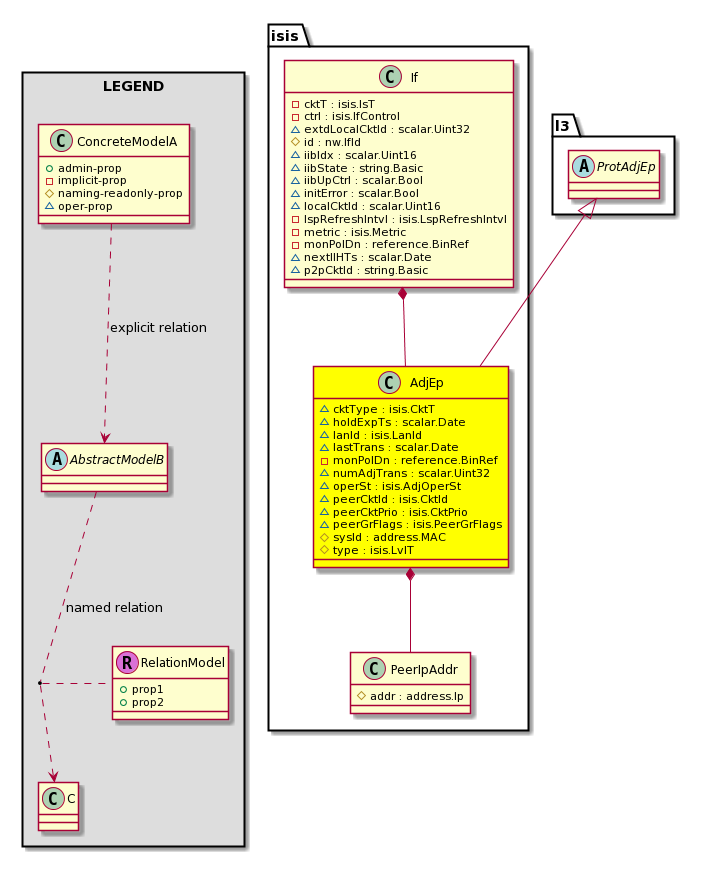| Properties Summary |
childAction
Type: mo:ModificationChildAction
Primitive Type: scalar:Bitmask32
Units: null
Encrypted: false
Access: implicit
Category: TopLevelChildAction
Comments:
-
Delete or ignore. For internal use only.
| |
| Constants |
| deleteAll |
16384u |
deleteAll |
NO COMMENTS
|
| ignore |
4096u |
ignore |
NO COMMENTS
|
| deleteNonPresent |
8192u |
deleteNonPresent |
NO COMMENTS
|
| DEFAULT |
0 |
--- |
This type is used to
|
|
cktType
Type: isis:CktT
Primitive Type: scalar:Enum8
Units: null
Encrypted: false
Access: oper
Category: TopLevelRegular
Comments:
-
The local operational circuit type.
| |
| Constants |
| p2p |
1 |
Point to point |
P2P
|
| bcast |
2 |
Broadcast |
Bcast
|
| DEFAULT |
p2p(1) |
Point to point |
P2P
|
|
dn
Type: reference:BinRef
Units: null
Encrypted: false
Access: implicit
Category: TopLevelDn
Comments:
-
A tag or metadata is a non-hierarchical keyword or term assigned to the fabric module.
holdExpTs
Type: scalar:Date
Units: null
Encrypted: false
Access: oper
Category: TopLevelRegular
Comments:
-
Expiry for hold time
lanId
Type: isis:LanId
Primitive Type: scalar:UByte
Units: null
Encrypted: false
Access: oper
Category: TopLevelRegular
Comments:
-
LAN Id
lastTrans
Type: scalar:Date
Units: null
Encrypted: false
Access: oper
Category: TopLevelRegular
Comments:
-
Last adjacency transition
modTs
Type: mo:TStamp
Primitive Type: scalar:Date
Units: null
Encrypted: false
Access: implicit
Category: TopLevelRegular
Comments:
-
The time when this object was last modified.
| |
| Constants |
| never |
0ull |
never |
NO COMMENTS
|
| DEFAULT |
never(0ull) |
never |
NO COMMENTS
|
|
monPolDn
Type: reference:BinRef
Units: null
Encrypted: false
Access: implicit
Category: TopLevelRegular
Comments:
-
The monitoring policy attached to this observable object.
name
Type: naming:Name
Primitive Type: string:Basic
Overrides:nw:Conn:name
Units: null
Encrypted: false
Access: admin
Category: TopLevelRegular
Comments:
-
The name of the object.
numAdjTrans
Type: scalar:Uint32
Units: null
Encrypted: false
Access: oper
Category: TopLevelRegular
Comments:
-
Number of adjacency transitions
operSt
Type: isis:AdjOperSt
Primitive Type: scalar:Enum8
Units: null
Encrypted: false
Access: oper
Category: TopLevelRegular
Comments:
-
Operational state of the adjacency
| |
| Constants |
| init |
1 |
Initializing |
Initializing
|
| up |
2 |
Up |
Up
|
| down |
3 |
Down |
Down
|
| gr-init |
4 |
Graceful restart initializing |
Graceful restart initializing
|
| DEFAULT |
init(1) |
Initializing |
Initializing
|
|
peerCktId
Type: isis:CktId
Primitive Type: scalar:UByte
Units: null
Encrypted: false
Access: oper
Category: TopLevelRegular
Comments:
-
Peer Ckt Id
peerCktPrio
Type: isis:CktPrio
Primitive Type: scalar:UByte
Units: null
Encrypted: false
Access: oper
Category: TopLevelRegular
Comments:
-
Peer Ckt Priority
| |
| Constants |
| defaultValue |
64 |
--- |
NO COMMENTS
|
|
peerGrFlags
Type: isis:PeerGrFlags
Primitive Type: scalar:Bitmask8
Units: null
Encrypted: false
Access: oper
Category: TopLevelRegular
Comments:
-
Peer graceful restart flags
| |
| Constants |
| capable |
1 |
Capable |
capable
|
| ack |
2 |
Acknowledged |
Acknowledged
|
| DEFAULT |
0 |
--- |
Peer graceful restart flags
|
|
rn
Type: reference:BinRN
Units: null
Encrypted: false
Access: implicit
Category: TopLevelRn
Comments:
-
Identifies an object from its siblings within the context of its parent object. The distinguished name contains a sequence of relative names.
status
Type: mo:ModificationStatus
Primitive Type: scalar:Bitmask32
Units: null
Encrypted: false
Access: implicit
Category: TopLevelStatus
Comments:
-
The upgrade status. This property is for internal use only.
| |
| Constants |
| created |
2u |
created |
In a setter method: specifies that an object should be created.
An error is returned if the object already exists.
In the return value of a setter method: indicates that an object has been created.
|
| modified |
4u |
modified |
In a setter method: specifies that an object should be modified
In the return value of a setter method: indicates that an object has been modified.
|
| deleted |
8u |
deleted |
In a setter method: specifies that an object should be deleted.
In the return value of a setter method: indicates that an object has been deleted.
|
| DEFAULT |
0 |
--- |
This type controls the life cycle of objects passed in the XML API.
When used in a setter method (such as configConfMo), the ModificationStatus
specifies whether an object should be created, modified, deleted or removed.
In the return value of a setter method, the ModificationStatus indicates the actual
operation that was performed. For example, the ModificationStatus is set to "created"
if the object was created. The ModificationStatus is not set if the object was neither
created, modified, deleted or removed.
When invoking a setter method, the ModificationStatus is optional:
If a setter method such as configConfMo is invoked and the ModificationStatus
is not set, the system automatically determines if the object should be created or modified.
|
|
sysId
Type: address:MAC
Units: null
Encrypted: false
Naming Property -- [NAMING RULES]
Access: naming
Category: TopLevelRegular
Comments:
-
Adjacency System ID
type
Type: isis:LvlT
Primitive Type: scalar:Enum8
Units: null
Encrypted: false
Naming Property -- [NAMING RULES]
Access: naming
Category: TopLevelRegular
Comments:
-
Adjacency type
| |
| Constants |
| l1 |
1 |
Level1 |
L1 type
|
| l2 |
2 |
Level2 |
L2 type
|
| DEFAULT |
l1(1) |
Level1 |
L1 type
|
|

